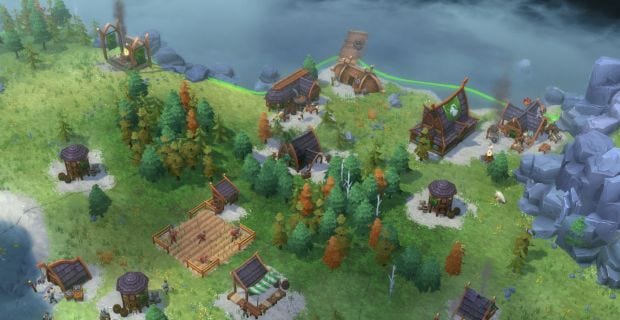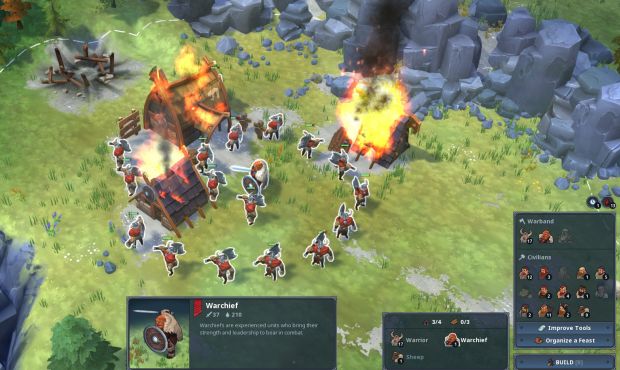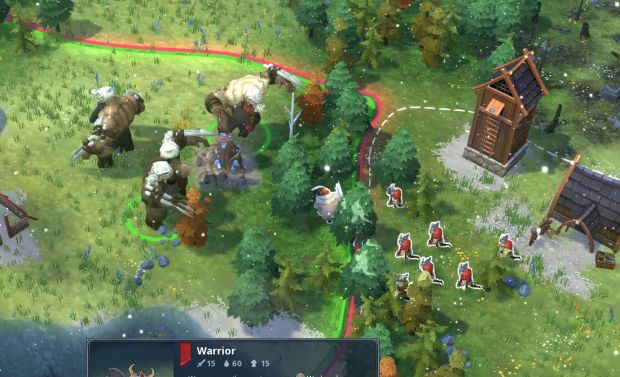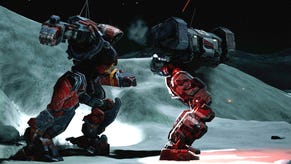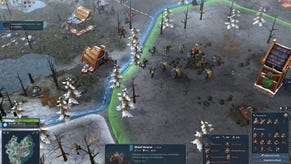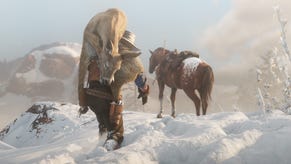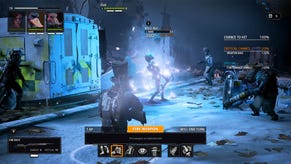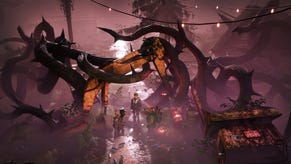Premature Evaluation: Northgard
Leaves your mouse hand Thor
Every Monday we send Brendan to scout the early access ruins for hidden treasures. This week, the careful Viking tactics of Northgard [official site]
This is Blainn, below. He’s just killed a Wyvern. He's my best mate because I gave him and his giant pals, the Jötunn, enough food to last a lifetime. They reckon we in the Goat clan are excellent humans and now Chief Blainn is fighting alongside us in our hoofed conquest of the whole land. This is one endgame that comes in Northgard, a rock-solid RTS about allocating and reallocating your Viking workforce in just the right way. Technically this match ended over an hour ago, when my opponent reached a “wisdom victory”. But it’s a testament to Northgard’s foundations that, when given the option to leave or continue following my defeat, I happily clicked “keep playing”.
Its cartoonish facade suggests a game of town building and ale-drinking. There is some of that – you need to build breweries and host feasts to keep your people happy, for example - but otherwise this is as classically expansionist and competitive as they come. There are a few ways to win. You can research the most “lore” for the aforementioned wisdom victory, you can kill all other clans for a conquest victory, or you can achieve the most notoriety by defeating monster’s lairs and raiding distant off-screen lands for a fame victory. In my own head, victory was not achieved until the whole map was coloured in red.
Here the land is already cut into pre-made slices. Each quadrant of the map has a resource or benefit waiting to be exploited and you can’t visit or invade one without first sending a scout to reveal the section. Some of these tiles have forests which boost the wood collected by any woodcutters there. Others have lakes where you can build fishing outposts, fertile land for farming, ruins for your treasure-seeking scouts to explore, stone or iron deposits to mine, stone circles containing “lore” (you need this to research new skills and clan-specific benefits). In other words, all the things a hearty Viking covets. Even a plot of “empty land” has the benefit of allowing you to build one extra structure there.
That each plot has a limit on buildings is one of its smart designs – it forces decisions on you at all times. Each tile can only house two or three buildings and you quickly find yourself agonising over what to build and where. There are rock deposits in this quadrant, you reason, I’ll definitely need a mine. But I also need a healer’s hut to keep my villagers healthy, a training camp to recruit warriors AND a new house to allow more villagers to arrive at my town hall. Without houses, the clan can’t grow, without warriors we can’t defend ourselves against encroaching wolves, draugr and other clans, and without healers those warriors will quickly die.
This can be solved by being an expansionist pig. Colonising new areas requires a large down payment of food, so it too is a costly choice, especially in the later stages as each successive tile becomes more expensive as you grow. But it’s an obvious necessity, not only because unclaimed tiles might have delicious resources but also because you just badly need the lebensraum. Growth is on your mind at all times and there never seems like enough room to build everything you want, as you discover via your scouts that you’re hemmed into a corner of the map by wolf lairs, draugr tombs, giants’ camps, canyons, ocean, and enemy clans.
I can’t tell if the maps are being randomly generated or if there’s a library of set geography with randomised tile contents. If it’s the former, then its an incredible map-maker – all the islands I played on had chokepoints, strategic lynchpins, wealthy areas, centralised goals (a legendary Wyvern to fight for fame and glory, for instance, or a portal to hell that will win you the game outright if you can control it for 12 months running). If the maps are predesigned and fashioned with randomised elements, then they are still very well made, geographically speaking. Each starting area always seemed to be purposefully cramped but in its own way that also meant it could be easily defended from monsters in the early game. As for rival clans, the need to explore the island tile by tile means that there are no rushed invasions or skirmish parties heading out across the map. In fact, even if you can see a rival clan’s home tile, your warriors can't delve that deep into a foe's turf. You can’t capture or colonise any tile without already owning one adjacent to it. This isn’t an RTS of speed, it's more one of thoughtful resource management and prioritising.
Your workforce is always central to any plan. Villagers slowly get pooped out of the town hall at your home tile and only at your home tile. Distance is always an issue and over-reaching is as much a threat as the monsters in the tile next to you. Multiple times I sent warriors to an unwise death and realised that I didn’t have the manpower to replace them, and even if I could the tiles they were most needed in were so far away and already under attack on by two different enemies that I wasn’t able to hold them all.
It’s a game of cautiously plucking people and reassigning their life’s work to suit you. Even so, you need to be careful with your wee folks because even a few deaths can knock you entirely off course. Your warriors die and you scramble to recruit new ones, so you have to take some woodcutters off their lumberjacking duty, which is fine for now, but still you might not have enough troops, so you recruit a farmer and a fisherman. Food might be tight, you think, but never mind, you need the soldiers because some portals to Helheim have opened and you’ll need men to deal with that come the winte-- oh s***, winter.
You see, there’s a small rolling calendar in one corner of your screen and when winter arrives the frost comes with it. Both wood and food deplete at a faster rate. Farms produce less and your warriors can’t fight as well in areas that don’t yet belong to you, suffering a combat penalty in the snow. It’s there on the ticking calendar, a little white bar that you roll through every year but still you sometimes fail to prepare correctly. One hasty colonisation in September can be a thoughtless drain on your food stocks. One round of upgrades to your houses and one rash building of a longship might see you run out of firewood prematurely.
In these cases people will likely become unhappy, which in turn causes them to produce less in their jobs. Then they begin to starve or die in the cold. “Well at least the houses are all very roomy now,” you might think. But before you know it winter is over and you have six fewer villagers to work with and the posh houses you just built are lying completely empty. Six deaths may not sound like a lot but in Northgard it can be devastating to your growth. And this is just a description of bad planning during a normal winter. Sometimes there are blizzards, winters so harsh that your food dwindles like it’s being eaten by rats. Sometimes it is being eaten by rats, because that’s another type of disaster that shows up, along with the hell portals and whiteouts.
These disasters always appear in good time though, as a little red exclam on your calendar. You just need to get into the habit of preparation and over-compensating for everything, having contingency plans, keeping your expansions in check with your capabilities. The only complaint I have with these is that there’s sometimes an earthquake disaster which sets many of your buildings on fire at once. The idea is that you need to quickly repair them and hope you have enough wood to repair them all. In practice, this is just an unpleasant clickathon, finding each individual burning edifice and clicking repair as quickly as you can, like playing whackamole with burning food silos. I would always have enough wood and if a building got destroyed in the post-quake fires it was always because I had too many buildings to click on, or simply didn’t spot one of them in my hasty glancing-over of the map. The other disasters and foreshadowed threats feel strong and concerning. The earthquake is the only one that feels both weak and annoying to deal with, purely from a mouse user’s point of view.
There are other downsides. Right now there’s still only a skirmish mode. It’s strong stuff, well worth a play for anyone hankering for some thoughtful arr-tee-essing. But it’s also sad that the campaign mode remains greyed out, slotted for some future update. Likewise multiplayer is currently non-existent. This is a strategy game that I feel will thrive online like a well-watered plant, providied it is also fed enough human waste. Playing with a few enemy AI clans on the normal difficulty can give you a good run but I imagine many will only lament the lack of a multiplayer when they see how tightly-woven the game itself is. Not me, obviously. I like my casual stroll over the map, plonking down altars and longboats and assigning little men to learn about better swords from giant runestones.
It’s an impressively well-made thing, a finely-embroidered cloak of an RTS with all the elements sewn together in a pleasing and sensible way. Most importantly, the immediate environment around your home feels like it really influences your strategy for the whole match. I once spawned in an area with three hunting grounds and a fishing lake nearby, but very little woodland or stone. I had to base my entire economy on stag fillet, placing food silos in every quadrant and blocking off access to our home canyon by quickly colonising a coastal passage into our land. From this position I could trade my plentiful food with both the peaceful giants and other AI players I discovered. From here you can use the money to buy materials in a marketplace (this building slowly accumulates wood, food, iron, and stone which you can buy for coin). In the long run, this is much more expensive than mining stone or chopping wood yourself but sometimes in the early and mid-game it is the best option. I later betrayed my trading partners and murdered them. They stopped buying stag fillets.
Eventually, the game ended when I got a wisdom victory of my own (one minor complaint is that this always seems to be the easiest route to victory). I had researched my little Viking heart out and achieved all the blessings of the gods. But, tellingly, I still clicked “keep playing”.
Northgard is on Steam early access for £14.99/$19.99. These impressions are based on build 1654541
